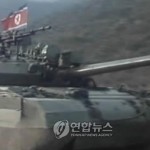Image from KCTV via Yonhap
According to Yonhap:
North Korea has deployed new battle tanks and bolstered the size of its special forces by 20,000 over the past two years, deepening the threat of unconventional warfare against South Korea, the South’s new defense white paper said Thursday.
The biennial defense paper also defined the North Korean regime and its military as the “enemy” of South Korea, a description stronger than before but short of reviving the symbolic tag of “main enemy” for the communist neighbor.
The new white paper was released as the South’s military resolved to strike back hard against future provocations by the North, which last month bombarded the South’s front-line island of Yeonpyeong, killing two marines and two civilians.
“Threats from North Korea’s asymmetric warfare capabilities such as special forces, artillery pieces and weapons of mass destruction have been on a steady rise since 2008,” Deputy Minister Chang Kwang-il told reporters.
Military officials here have said the North is increasingly focused on unconventional or “asymmetric” weapons, such as improvised explosives or low-cost missiles because the regime knows its aging conventional weapons are no match for the technologically superior South Korean and U.S. forces
The white paper confirmed for the first time that North Korea deployed its new battle tank, called the “Pokpung-ho,” which in Korean means “Storm Tiger,” believed to have been developed in the 1990s based on the Soviet Union’s T-72 tanks.
The North’s new tank is presumed to be equipped with either a 125- or 115-millimeter main gun, similar to that of the T-50 battle tank of the Russian Army, defense ministry officials said.
The paper didn’t say how many of the new tanks North Korea has “deployed for operational use,” but said the number of North Korean tanks rose to some 4,100 units as of November this year, from 3,900 in 2008.
Also, the paper said the number of lightly equipped North Korean special forces, who are trained to quickly infiltrate South Korea, increased to 200,000 from 180,000.
Overall, the total number of North Korean soldiers remained unchanged at about 1.19 million, but the North has reorganized its military to add four new divisions, the paper said.
Although its number of artillery pieces changed little over the past two years, its 170mm self-propelled artillery and 240mm multiple rocket launchers deployed on the front line are capable of carrying out a “massive surprise bombardment” on the South Korean capital of Seoul and its neighboring areas, the paper said.
North Korea is “presumed to have secured about 40 kilograms” of weapons-grade plutonium by reprocessing spent nuclear fuel rods four times by 2009, the paper said.
Concerns about the North’s nuclear weapons program deepened last month when Pyongyang, which conducted two nuclear tests in 2006 and 2009, revealed a uranium enrichment facility to a visiting U.S. scientist. The uranium enrichment program could give the North a second route to build a nuclear bomb.
“Given that North Korea claimed that some 2,000 centrifuges are operational in November 2010, the North is presumed to have pushed for the highly enriched uranium (HEU) program,” the paper said.
Early this week, Chang told reporters that his ministry decided not to revive the “main enemy” tag for the North to “minimize controversy,” because the defense white paper is an official government document that is “used internally and externally.”
Thursday’s defense paper clarified that the “North Korean regime and military are our enemy” that poses a “grave threat” to the South’s security by “staging military provocations such as the torpedo attack on the Cheonan warship and the shelling on Yeonpyeong Island.” Forty-six sailors were killed when the North allegedly torpedoed the Cheonan warship in March in the Yellow Sea.
“Not using the expression ‘main enemy’ does not mean that we softened our stance,” Chang said.
The new description is aimed at sending a strong message of warning to the North and clarifying that the North Korean regime and its military, not the people, are aggressors, according to the official.
South Korea first used the label “main enemy” for North Korea in its 1995 white paper after North Korea threatened to turn Seoul into a “sea of fire” a year earlier. Seoul stopped using the expression in 2004 in an apparent bid not to antagonize Pyongyang amid then-thawing ties.
In its defense paper published in 2008 under the government of President Lee Myung-bak, South Korea called North Korea an “immediate and grave threat” to its national security.
The two Koreas are still technically at war because the 1950-53 Korean War ended in a truce, not a peace treaty. About 28,500 U.S. troops are stationed in the South, a legacy of the three-year war.
Additional information:
1. This web page does not focus on military affairs (except when it overlaps with Google Earth research or broader economics), but I have put some military information resources here for the convenience of readers. Please let me know if anything should be added.
2. I have kept a chronological list of Yonpyong stories here.
3. I have kept a chronological list of stories related to the DPRK’s new uranium facilities here.
Read the full story here:
N. Korea deploys new battle tanks, boosts special forces
Yonhap
Kim Deok-hyun
12/30/2010

